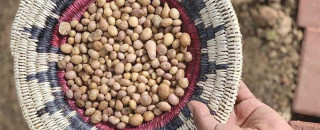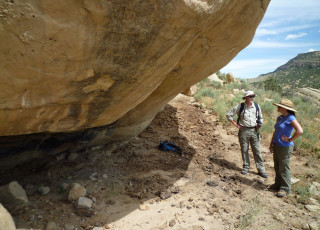Genetics reveal ancient trade routes and path to domestication of the Four Corners potato
Genetic analysis shows that ancient Indigenous people transported, cultivated and may have domesticated the native tuber outside of its natural distribution, reflecting the enduring ecological legacy of Indigenous people in the Southwestern U.S.
A new study shows that a native potato species was brought to southern Utah by Indigenous people in the distant past, adding to an ever-growing list of culturally significant plant species that pre-contact cultures domesticated in the Southwestern U.S.
The team of researchers, led by Red Butte Garden and the Natural History Museum of Utah (NHMU) at the University of Utah, used genetic analysis to reveal how and where tubers of the Four Corners potato (Solanum jamesii) had been collected, transported and traded throughout the Colorado Plateau. The findings support the assertion that the tuber is a “lost sister,” joining maize, beans and squash—commonly known as the three sisters—as a staple of crops ingeniously grown across the arid landscape.
“Transport is one of the early crucial steps in the domestication of native plants into crops," said Dr. Lisbeth Louderback, curator of archaeology for NHMU, associate professor of anthropology at the U and coauthor of the study. “Domestication can begin with people gathering and replanting propagules in a new location.”
The authors collected DNA samples from modern Four Corners potato populations near archaeological sites and from non-archaeological populations within the potato's natural range in the Mogollon Rim of central Arizona and New Mexico. The findings indicate that the potato was transported and cultivated, likely by the ancestors of modern Pueblo (Hopi, Zuni, Tewa, Zia), Diné, Southern Paiute and Apache tribes.
"The Four Corners potato, along with maize, cacao, and agave, reflects the significant influence of humans on plant diversity in the
landscape over millennia,” said Dr. Bruce Pavlik, former director of conservation at Red Butte Garden and lead author of the study.
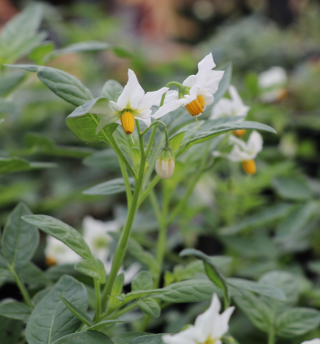
Solanum jamesii plant, the Four Corners potato Tim Lee/NHMU
The paper published on July 12, 2024, in the American Journal of Botany.
S. jamesii has twice the protein, calcium, magnesium and iron content than an organic red potato, and a single tuber can grow to yield up to 600 small tubers in just four months. The nutritious crop would have been a highly valued trade item and crucial in the lean winter months. While the unique distribution of the Four Corners potato came as a surprise to scientists and researchers, local Tribal members suspected this all along.
“The Southwest was an important, overlooked secondary region of domestication. Ancient Indigenous People were highly knowledgeable agriculturalists tuned into their regional ecological environs who traded extensively and grew the plants in many different environments,” said Wendy Hodgson, herbarium curator and research botanist at the Desert Botanical Garden. “Such studies highlight the need to learn from Indigenous Peoples’ perspectives, ethnographic reports, and to view landscapes and some plant species from a cultural, rather than ‘natural’, perspective.”
The lost sister
The Mogollon Rim region encompasses southcentral Arizona, extending east and north into the Mogollon Mountains of New Mexico. Jagged limestone and sandstone cliffs break up the ponderosas, pinyons and junipers scattered across the high-altitude terrain. S. jamesii is widely distributed across the Rim—the plants thrive in conifer woodlands, and thousands of small tubers can grow beneath a single pinyon pine canopy. These “non-archaeological” populations lack an association with artifacts, grow to be quite large and are continuously distributed across the habitat.
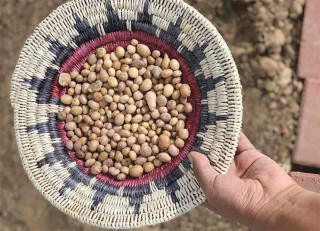
Four Corners potato tubers in a basket Alastair Lee Bitsóí (Diné)
In contrast, “archaeological populations” of the potato occur within 300 meters of ancient habitation sites and tend to be smaller than in the species’ central distribution. The sparse, isolated populations across the Colorado Plateau exhibit a genetic makeup only explained by human gathering and transport.
“Tribes of the Four Corners region have nurtured a connection to food and landscape biodiversity since time immemorial,” said Alastair Lee Bitsóí (Diné), a Navajo journalist who grows and reports on the Four Corners potato. “I've grown spuds from Bears Ears, Grand Staircase and Mesa Verde region at my family's farm in the Navajo Nation, and from them a new generation has been born. Like the ancestors, I am a dispersal agent for its transport and cultivation.”
To reproduce sexually—that is, to create viable seeds—flowers must receive pollen from a different plant with specific, compatible genetic factors. Without the right companion, plants will clone themselves by sprouting from underground stems to create a genetically identical daughter plant. Its cloning capability allows S. jamesii to persist even when conditions are far from ideal. It also provides a genetic stamp marking where each population originated. This signature is common in potatoes carried to locations with few other individuals and persists for hundreds of generations.
Researchers collected DNA samples from 682 individual plants across 25 populations of the Four Corner potato—14 populations were near archaeological sites, while 11 were from non-archaeological areas in its natural distribution. The results showed that the most genetically diverse populations of S. jamesii were concentrated around the Mogollon Rim. Conversely, populations from archaeological sites exhibited reduced genetic diversity because the transported tubers may have only contained a fraction of the available genes.
Tracing the origins of archaeological populations
The authors found that populations of S. jamesii in Escalante Valley in Southern Utah have two different origins—one directly from the Mogollon Rim region and one related to Bears Ears, Mesa Verde and El Morro. These archaeological sites form a genetic corridor suggesting ancient people transported the tubers north south to north transport of tubers.
Despite being close geographically, four archaeological populations around Escalante Valley show distinct origins. The genetic signatures could indicate that people transported potatoes to new locations multiple times in the distant past in a pattern likely corresponding to ancient trade routes.
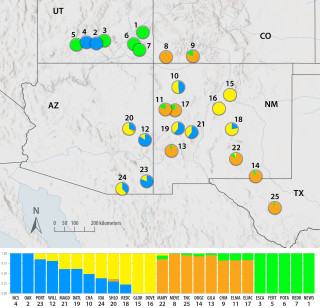
Map showing genetic structure by ancestry. Each bar represents the genetic composition of a given potato population and shows where the genes came from. Pavlik Et. Al. AMJBotany (2024)
“The potato joins a large assemblage of goods that were traded across this vast cultural landscape,” said Louderback. “For millennia, people of the southwest participated in social networks, migration and trade routes in the region.”
What is clear is that the species has been transported and grown far from its center of natural distribution. Scientists from the USDA Potato Gene Bank have been sampling the genetics of the Four Corner’s potato for decades and were intrigued by the diversity of genetic patterns along the geographic range.
“We used to wonder about the patterns of genetic diversity distribution of Solanum jamesii,” said Dr. Alfonso del Rio, plant geneticist at the University of Wisconsin-Madison and the U.S. Department of Agriculture Potato Genebank and coauthor of the study. “It wasn't clear to us that humans had altered its range, but now we have evidence confirming just that."
The researchers interpret the transport of the Four Corners potato as early stages of domestication, however, they plan to analyze specific gene sequences to learn more about S. jamesii.
“We’d like to look at specific genetic markers for certain desirable traits such as taste, tuber size and frost tolerance,” said Pavlik. “It's entirely possible that Indigenous people were preferring certain traits and thus trying to encourage favorable genes.”
“Agave, the Four Corners potato, and other domesticated species are excellent candidates for arid land cultivation at a time when we are faced with many challenges including food security and water resource availability,” said Hodgson. “As illustrated in this and other studies, protecting and understanding the distribution, and ecological and cultural roles of these plants require interdisciplinary collaboration between botanists, archaeologists, federal agencies and Indigenous Peoples.”
******
Dr. John Bamberg of the USDA Potato Bank was also a coauthor of the study, titled “Evidence for human-caused found effect in populations of Solanum jamesii at archaeological sites: II. Genetic sequencing established ancient transport across the Southwest USA” in the American Journal of Botany. The work was funded by the National Science Foundation (award # BCS-1827414), the Natural History Museum of Utah at the University of Utah, University of Wisconsin-Madison, and the USDA Potato Genebank.
About the Natural History Museum of Utah
The Natural History Museum of Utah is one of the leading scientific research and cultural institutions in the country. Established in 1963, the museum’s 10 permanent exhibitions are anchored by its state-of-the-art collections and research facilities containing almost 2 million
objects. These collections are used in studies on geological, biological, and cultural diversity, and the history of living systems and human cultures within the Utah region. The museum hosts approximately 300,000 general visitors a year and provides one of the most spectacular private event settings in the Salt Lake City area. NHMU also broadens the reach of its mission through a variety of science-based outreach programs to communities and schools throughout Utah, reaching every school district in the state every other year.
Press contacts and links
-
Press Contact
Margaret Chamberlain
Public Relations Specialist
-
Press Contact
Lisbeth Louderback, Ph.D.
Curator of Archaeology
-
Press Contact
Bruce Pavlik
Director of Conservation, Red Butte Garden
Press Links
